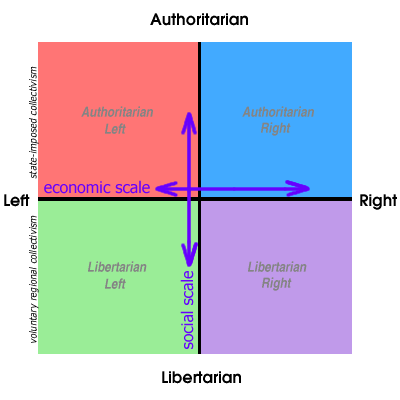Last year I created a art version of a political compass, if you have never heard of a political compass before, it is an imperfect guide to what political system your beliefs align with.
the test can be taken here: www.politicalcompass.org/test
 |
| Example of a 'Political Compass' Source: www.politicalcompass.org |
Above is the basic layout of political compass, and below is the Artistic version; the X axis has originally left and right alignments in the political compass has been replaced with 'Documentation' as the far right and 'Expressive' on the far left, and the Y axis has replaced 'Libertarian' at the bottom with 'Abstract' and 'Authoritarian' at the top with 'Realistic'.
Each of these Axis refers to the style and conceptual ideal surrounding your art, for a better understanding of the different alignments there must be a list of definitions for the words here used, otherwise confusions may be made;
Realistic - Art that is Figurative or depicts images and objects that exist.
Abstract - Non-representational of anything that exists.
Expressive - Art that is made to appeal to or display the emotions of the Viewer or Artist. (Hot art)
Documentation - Art that is focused on pure data or process. (Cold art)
for an exact chart definitions of each area should be carefully explained, for example the area marked 'Surrealist' may not refer to the Surrealist movement as that wold create a confusion as there are many artists concerned with the movement each with different ideas, instead 'Surrealist' in this case refers to a style that is somewhat a 'Documentation' and somewhat 'Realistic' but not extremely so, the work of Paul Delvaux may fit this area.
the chart can be further divided, for example drawing a diagonal line from the bottom left to top right, and vice-versa from the top left to the bottom right. we have to opposing approaches to creating art; 'Method' and 'Skill'
Bottom left to top right - Skill
These art forms have a stronger focus on the skill of creating the art, for example the skill in applying paint.
Top left to bottom right - Method
These art forms focus on the method and process to create art, for example 'conceptual art' or 'generative art'
A 'Z Axis' can be added to the chart also making it a cube (see image below) this axis would be called the 'Purpose' of the Art work.
Z Axis - Purpose
-10 = Inner Purpose: Artwork made for the artists own needs or pleasure. Eg. Outsider art, Children's Drawings or the Hobby artist
+10 = Outer Purpose: made for a reason outside of artist's necessary need to create. Eg. Design
0 = Center Purpose: made for equal reasons or reason for creation is unknown. Eg. Cave Art
 |
| Example of a 4d 'Political Compass' cube |
Test to Examine Alignment on Chart:
I also created a test to determine your alignment on the chart (results of test below)
Although we must keep in mind that this chart can be somewhat problematic, as an artist's process may be different from the final outcome. and also when evaluating sculpture an issue of realistic arises, can an abstract sculpture be accurately evalued? or performance art for that matter?
And also the issue of a neutral position on the opinion of style, this may occur if a art historian was to take the test, a neutral opinion does not obtain to any style but rather an acceptance of all styles or indifference towards varying styles.
I encourage feed back on the durability of this chart.
Questions:
strongly disagree: -3
disagree -2
neither agree nor dis agree 0
agree 2
strongly agree 3
Expression:
1. Art should be an escape
2. I create art/or I think art's primary goal is to communicate
3. Colour is more power full than figurative in artworks
4. art is best when used to express
Realistic:
1. Art should depict a subject matter that exists
2. I do not like abstract imagery
3. the audience cannot get anything 'out' of an abstract image
4. I value the skill involved in creating a realistic image
4. a lot of writing about art is too abstract and hard to read
Documentation:
1. Art should reference real life
2. concept over process
3. art should confront
4. art should involve science and culture not bullshit concepts and theories
Abstract:
1. art is a free flowing term
2. the first task of an artist is to free themselves from the tradition of old European art
3. good depiction of figurative images does not mean good skill
4. art is about interpretation
| Name | Person A | Person B | Person C | Person D | Person E | Person F | (extremes) |
| Expression | 9 | 1 | 8 | 6 | 1 | 1 | 11 |
| Realistic | 3 | 7 | 0 | 7 | 8 | 0 | 11 |
| Documentation | 3 | 10 | 3 | 8 | 8 | 6 | 11 |
| Abstract | 1 | 0 | 10 | 2 | 0 | 10 | 11 |
Early Examples of the Art Compass.
Although we must keep in mind that this chart can be somewhat problematic, as an artist's process may be different from the final outcome. and also when evaluating sculpture an issue of realistic arises, can an abstract sculpture be accurately evalued? or performance art for that matter?
And also the issue of a neutral position on the opinion of style, this may occur if a art historian was to take the test, a neutral opinion does not obtain to any style but rather an acceptance of all styles or indifference towards varying styles.
I encourage feed back on the durability of this chart.




